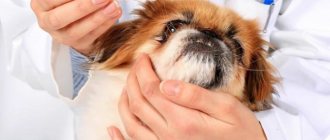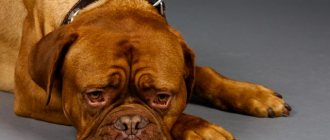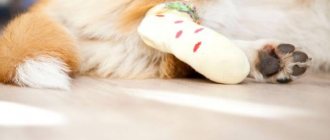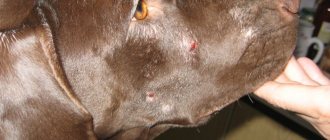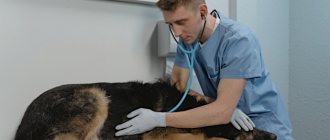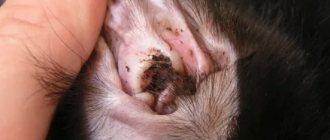A dog's hearing is several times better than that of a human. Thanks to this, your pet senses your approach from afar and meets you at the door. A dog's hearing helps your pet, even in sleep, to listen to any extraneous sounds in order to be ready at any time to sound an alarm and protect you. This acute hearing helps your dog distinguish hundreds of intonations in your voice and respond correctly to what is said. And in order for your pet to retain its amazing abilities, its ears need to be properly cared for.
How do you know if your dog has an ear infection?
Typical symptoms of an ear infection in dogs
- Scratching the ear or area around the ear.
- Brown, yellow, or bloody discharge.
- Smell in the ear.
- Redness. Edema. Crusts or scabs on the inside of the outer ear.
- Hair loss around the ear.
- Rubbing the ear and surrounding area against the floor or furniture.
- Shaking the head or tilting the head.
THIS IS INTERESTING: A frequent question: is it normal for a dog to experience constipation after sterilization?
Types of ears
Different dog breeds have different ears based on the following criteria.
By shape
Depending on the shape of the tips, the ears can be pointed (for example, like a German Shepherd) or rounded (typical for Bassend Hound dogs).
According to the strength and structure of cartilage
In this case, the ears are classified as:
- standing (fully raised above the head);
- semi-erect (the cartilage is strong only in the lower part of the ear, and closer to the tips it becomes thinner and more elastic, causing the ends of the ears to bend down);
- hanging on cartilages (the base of the ears has strong cartilage, but the main part of the ear hangs down - the fold line runs approximately at the level of the forehead);
- hanging (ears hang immediately at the base, without forming a clear break line).
By size
Relative to the size of a dog's head, erect ears can be large, medium, small or small, while floppy ears vary in length and width.
By delivery
Ears can be wide-set, close-set, floppy, high-set, or low-set.
By other criteria
The degree of development of the subcutaneous tissue of the ears (fleshy, folded, dry, heavy), the degree of fouling of the ears with hair, their mobility and other criteria are also taken into account. There are heart-shaped, tulip-shaped, triangular, and even rose-shaped ears.
Each of the listed qualities can determine not only the dog’s compliance with breed standards, but also its temperament. Thus, moving, pointed ears usually indicate the dog’s lively and spontaneous character, sometimes its insatiable curiosity. And low-set, “burdock-shaped” ears often indicate a phlegmatic and philosophical nature of the pet. But this is not always the case, and an enthusiastic beagle with floppy ears may turn out to be more active than a timid Yorkshire terrier. But if all ears are so different, how to properly care for your dog?
Auricular hematoma
The cause of the disease is injury to the ear. The presence of a hematoma is indicated by thickening or swelling of the ear, its sagging, or the dog's head tilting to the side.
Hematoma is treated by applying a pressure bandage for 5-6 days, then opening and removing dead tissue. Large wounds are stitched. After the operation, the ears are wrapped around the head and a bandage is applied. Healing occurs within 10-12 days. For better healing, the bandage is applied with ointments Levomekol, Methyluracil, Solcoseryl.
Features of ear care
To ensure proper ear care for your pet, you should follow several general principles.
Maintenance must be regular
After each walk, you should inspect the dog’s ears in order to notice and remove ticks in time (ears, paws and tail are favorite places of attachment). Once a week, the ears need to be examined in more detail, looked into the ear canal, and, if necessary, cleaned and treated. To clean and disinfect your ears, you can use Bars lotion, which has disinfecting properties and facilitates the removal of dirt, earwax and secretions resulting from infectious or inflammatory diseases of the ears.
Care must be gentle
Dogs' ears are very sensitive and vulnerable. Therefore, for cleaning you should use only safe tools and products approved for use in veterinary practice. To clean the inside of the ear, place 2-5 drops of warm lotion inside. Then, soak a swab or cotton pad in the lotion, gently wipe the inside of the ear. After this, change the disc and soak it in the lotion again, gently wipe the curls at the base of the ear, without going deeper. These steps should be repeated until the surface of the cotton pad remains clean. You should not clean the inside of your ear with chopsticks; it is too easy to cause damage.
Care must be rational
If your dog has a lot of hair on the inside of the ears (especially long hair), it should be trimmed regularly with round-edged scissors or plucked according to breed standards. Long hair protects the pet's ear canal to a certain extent. But it also prevents the removal of dirt and wax from the ears and serves as a reservoir of impurities that can harm the dog’s health.
Foreign body
A dog is not a child and cannot put a foreign object in its ear. But it is not uncommon for grass or tenacious plant seeds, burdock or an insect to accidentally get into the ear. The foreign body causes discomfort to the dog - the dog persistently rubs its ear with its paws and whines. It is necessary to examine the ear yourself as quickly as possible or take your pet to a veterinarian. If a foreign body remains in the ear for a long time, serious inflammation may develop, which will require long-term treatment.
Why they don’t get up - reasons and solutions
Newborn puppies are born with small ears pressed to their heads. As the animal grows, they straighten out, the cartilage strengthens and they take on a vertical position.
The time has come, but the dog’s ears don’t stand up. Why? The answer to this question is often of great concern to owners. The process of ear raising is influenced by five main factors:
- Genetic inheritance.
- Unpurebred (mixed puppies).
- Lack of calcium in the body.
- Too thick (fleshy) ears.
- Thin and weakened.
The main thing is not to panic and not to give up. Problematic ears need human help and can be fixed. The set of activities includes:
- proper nutrition;
- special vitamins;
- manual massage;
- ear gluing.
Nutrition
If the puppy's diet does not have enough calcium, or he did not get enough of it through his mother's milk, his ears may droop. In this case, you need to review your pet's menu.
Small breed puppies born from bitches who have suffered from postpartum eclampsia (loss of calcium in the blood) will most likely have problems with ear placement!
You can add calcium to your dog’s body using natural goat’s milk or calcium-enriched cottage cheese. It is not difficult to prepare it at home.
Recipe for making calcined cottage cheese
Edible gelatin, which can be added to the puppy’s food or prepared aspic dishes based on it, will help your dog replenish the lack of calcium.
Excess calcium in a pet’s body is no less dangerous than its deficiency. In this regard, it is important to comply with the daily norm of its consumption.
Vitamins
To strengthen cartilage tissue, special vitamins should be added to the puppy’s main diet: Excel, Polydex, Canina, Beafarm, Calcefit, Volmar, Kanvit. Vitamin “Steed Plus” is good for lifting weak ears, but it is quite expensive and you can’t buy it in every store.
“Silver Trail” Calcium Peptide is a little-known Russian brand. Its natural composition and nano-method of supplying calcium to the bone and cartilage tissue of animals receive the highest marks from experts.
Before purchasing and using zoovitamins, you must consult a veterinarian.
Massage
Massage is an additional measure to solve the problem of drooping ears. It helps in combination with nutrition and vitamins. It is not difficult to do, and the dog perceives the massage as if it were affection.
During this time, the puppy should not be distracted and should be completely relaxed. Grasp the base of your baby's ear with your thumb and index finger. Using kneading massage movements, work the cartilage itself and move towards the tip, slightly pulling and directing the blade vertically. Perform several massage techniques at once in this way.
The massage will not harm the ears and the number of procedures during the day is unlimited . Thanks to it, blood flow increases in the tissues, which has a beneficial effect on the process of strengthening and maturation of cartilage tissue.
Treatment
Treatment of the ears should be aimed at the cause of inflammation and itching. It is important to maintain hygiene and not allow your dog to itch. To prevent scratching, you can use a collar, but the best solution is Apoquel. This is an innovative drug for relieving itching during diagnosis and treatment. It solves the problem at the cellular level and is well tolerated by the four-legged friend.
For each case there is an individual treatment that must be prescribed by a veterinarian. In order for the doctor to see the clinical picture as much as possible, do not treat the dog’s ears with anything before the doctor’s appointment.
Why should they be installed?
It is necessary to put ears on dogs so that the pet does not raise doubts about its elite status. Erect ears give animals a more aesthetic and impressive appearance. This issue is especially important for exhibition animals.
If the identified defect of lop ears is not a congenital defect and was not obtained as a result of injury, then simple manipulations will help correct the situation (in other cases, the help of a veterinarian and surgeon will be required).
Some dog owners do not consider ear studs necessary. Moreover, the standard of many breeds allows them both standing and hanging positions. In any case, the choice remains with the person, and the dog is completely indifferent to what ears it has, because this will not affect its devotion and love.
Otodectosis
This is a parasitic disease caused by ticks of the genus Otodectes cynotis. The mite feeds on earwax, lymph and epidermis. The vital activity of the parasite causes unbearable itching and inflammation in dogs. Only a veterinarian can confirm the diagnosis of otodectosis after examination and laboratory diagnosis of the discharge - the mite can be easily seen through a microscope.
Dogs suffer from otodectosis much less frequently than cats. But a dog can easily pick up this parasite on the street or from a sick feline.
Treatment for otodectosis is quite simple - hygienic cleaning of the ears and a drug aimed at destroying the Otodectes cynotis mite. Simparica tablets are excellent for treatment and prevention. They do not have a toxic effect on the dog’s body, but are highly active against mites that cause otodecosis.
In addition to tablets, ear mites respond well to treatment with Stronghold drops. For complete recovery, one or two treatments with an interval of 30 days are enough. In the future, the drug can also be used for prevention.
Bonding - pros and cons
The “gluing” method helps to radically make your puppy’s ears droop. It has proven itself in practice and is widely used for installing cropped and undocked ears on various breeds of dogs.
Some pets behave excitedly after gluing. They try to rip off the bandage and the structure with their paws, and rub their heads against the furniture. This way they can damage the ear cartilage and make the situation worse. In this case, you should loosen the tie and wrap or put on a special protective “collar” for the puppy.
Sometimes, after removing the adhesive plaster, an allergic reaction, pimples or scratches are clearly visible on the ears. Suitable for their treatment:
- baby powder;
- hydrogen peroxide;
- pharmacy blue.
After the ears have rested, the wounds have healed, and the crusts have dried, you will need to repeat the gluing procedure.
The “gluing” method is completely safe for the physiology of the animal and has no contraindications. This procedure should be carried out carefully, observing all preparatory and main steps.
What problems do puppies have with their ears?
There are problems that can occur in a wide variety of breeds, regardless of ear shape and size. This:
- infection with ear mites;
- mechanical damage and injury;
- foreign objects entering the ear;
- water ingress;
- infections, viruses, fungi.
If you don’t take care of your pet’s hygiene and don’t clean his ears regularly, some of these problems may affect him too. Ears get dirty pretty quickly if they get neglected. This creates fertile ground for various infections, especially since most breeds have fur in their ears, which prevents air circulation, and this only benefits microbes and viruses.
For the same reason, drooping ears require more attention, as the air flow into them is worse than into ears that are specially cropped or those that naturally stand up.
Some ear problems in puppies can be classified as “man-made.” Take, for example, representatives of the Chihuahua breed, whose ears should stand up, but for some reason they hang down like those of a mongrel. What do the owners of the unlucky Chihuahua do in this case?
They commit violence against nature by gluing the pet’s ears with a plaster or some kind of glue. In this case, the delicate skin is damaged, the wounds get infected, not to mention the pain of all these procedures for the baby.
Experts insist: if you are going to change the set of the ears (this also applies to other breeds, not just Chihuahuas), then you need to do it in such a way as not to harm the puppy - special methods have been developed for this, there are the necessary medications and even special plasters. Your puppy will not even experience discomfort, and the requirements of the breed will be met.
How to train a dog to clean its ears?
Correct and effective cleaning of dog ears is only possible if the animal itself is favorable to the procedure. In this case, it will not spin around or try to escape.
It’s easy to accustom your pet to regular ear cleaning:
- For the first few cleanings, make sure your dog is fed, walked, and in a good mood. If your pet is not feeling well or is sick and ear cleaning can wait, reschedule it for a more convenient time.
- Talk to the dog in an even, calm tone, pat its withers, or perform any action with which you usually approve or praise your pet.
- Sit down and have your dog sit in front of you - for the first time this can be done comfortably by placing your pet between your knees and squeezing him lightly. Make sure you have everything you need on hand - tampons and discs, ear cleaning lotion.
- Carry out cleaning carefully, making sure not to hurt the dog with careless or too strong movements.
- After completing the procedure, praise your pet and treat him with a treat.
Diagnostics
Only a veterinarian can make a diagnosis based on anamnesis (collection of information about the pet’s lifestyle), examination and additional research. For example, otoscopy of the middle and inner ear will make it clear where the inflammatory process is localized, and microscopy of the discharge from the auricle will show what exactly could cause the inflammation.
What symptoms may bother your dog besides itching:
- pain - the dog will whine and actively rub its ear with its paws, tilting its head. Trying to look may cause anxiety, discomfort or aggression on the part of the animal;
- a “squelching” sound when pressing on the base of the ear or when the dog shakes its head;
- local redness of the skin, swelling;
- discharge from the ear that is black, gray, yellow or off-white;
- foul odor from the ears;
- enlarged submandibular lymph nodes, general depressed condition of the dog, lethargy;
Each of these symptoms indicates that something is wrong with your ears. The solution to the problem must be approached comprehensively and as quickly as possible.
Itchy ear - what could it be?
Other parasites
In addition to ear mites, other parasites also attack dog ears - fleas, subcutaneous mites (demodex), scabies mites (sarcoptic mange), and ixodid (forest) mites. Bloodsuckers can be located anywhere on a dog’s body; they also love the ears, because the skin on them is tender enough to easily bite through it. The bites also cause itching. And when a dog itches, it can injure its ear. Trauma can cause both local inflammation and otohematoma. In addition to causing discomfort, fleas and ticks are carriers of dangerous diseases. Therefore, it is much easier to prevent all parasitic diseases than to treat their consequences.
The optimal solution for prevention is Simparica tablets. They protect against fleas and several types of ticks at once - ixodid (forest), ear (otodectosis), scabies (sarcoptic mange), subcutaneous (demodectic mange). In the warm season, the tablet is a dog’s salvation from many parasites and the diseases they carry.
